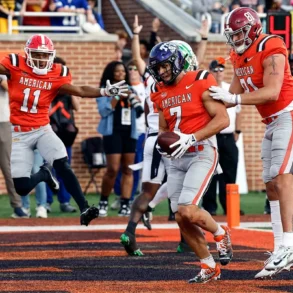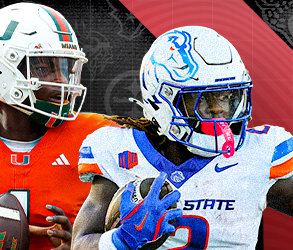
Jason Mowry/Getty Images
Days before he helped his team to a national championship, Chip Kelly, one of the great football minds of our lifetime, beamed with energy.
While Kelly hasn’t always been regarded as a bubbly personality within the sport, his day at media days prior to the title game was a different story. He was polite and engaging. He was detailed—if not captivating—when asked to talk about actual football.
“It’s been great,” Kelly said about his time in Columbus, having assumed the role of offensive coordinator the previous offseason. “We have an amazing staff and the guys you work with on a daily basis. I’ve really enjoyed this last—I don’t know how many months I’ve been her— eight, nine months. It’s been awesome.”
As it turns out, Kelly had one foot out the door at this exact moment. While it’s hard to know exactly when he agreed to become the offensive coordinator for the Las Vegas Raiders, it would appear that Kelly will do just that next season.
And according to Sports Illustrated‘s Albert Breer, he will be paid $6 million dollars to do so.
No one can blame Kelly for leaving. Not for the opportunity to return to the NFL or the possibility to boost his already robust salary by nearly 300%. But Kelly’s departure is yet another piece of a very complicated puzzle currently blanketing all programs trying to win a national championship in these strange times.
Win now, or else. Because the only guarantee is that change is the new constant. And the money will be spent no matter what.
Kelly wasn’t the only meaningful departure hitting the Buckeyes in the afterglow of one of the greatest moments in program history. Defensive coordinator Jim Knowles didn’t even make it to the team’s celebration before taking the same position at rival Penn State for a reported $3.1 million per year for the next three years.
To put this in the appropriate context, LSU’s Blake Baker was the highest paid assistant coach this past season with a total salary of $2.5 million, according to USA Today‘s assistant salary database. Knowles came in third at $2.2 million.
A raise of nearly one million dollars didn’t just provide a shakeup in the conference. It was a complete reset of the assistant coaching market. More specifically, it was another instance of money—enormous, Scrooge McDuck piles of money—serving as the difference between being great and being elite.
The hope for Penn State is that Knowles will do what he did for Ohio State, and he’ll be paid more than an assistant coach in the history of the sport to do just that.

Jason Mowry/Getty Images
The departures of Kelly, Knowles and offensive line coach Justin Frye, who has been a catalyst for this team, are just a piece of the puzzle. Ohio State will also say farewell to a litany of critical players—running backs TreVeyon Henderson and Quinshon Judkins, quarterback Will Howard, wideouts Emeka Egbuka, defensive linemen Jack Sawyer and JT Tuimoloau, offensive lineman Donovan Jackson, cornerback Denzel Burke and others.
The best roster in college football cost a reported $20 million to assemble. The coaching staff, which was the most expensive in college football, was equally vital. And the culmination of the time and investment was indeed a national title.
Although that’s perhaps all that was earned.
In a report released by the NCAA, the Buckeyes’ athletic department showed a deficit of $37.7 million in 2024.
The math behind it is a bit complicated. Ohio State had only six home games in 2024, which certainly didn’t help these figures. The year prior, it had eight.

John Cordes/Icon Sportswire via Getty Images
In general, revenue was $254 million versus $279 million in 2023. Included in this was more than $9 million in severance payments to former staff members.
“While last year’s budget impact is not ideal and there were unique circumstances at play, we have a robust expense and revenue plan that has been implemented and have made great progress in this ever-changing landscape of college athletics,” said Ohio State athletic director Ross Bjork in a release. “We will make sure we operate with a balanced budget moving forward.”
Whether the shortfall was a surprise or not, one thing is clear. Winning in college football is more expensive than it has ever been.
Was it worth it? That depends on who you ask.
Building a team costs money. Building a staff costs more money. Replacing a staff costs money. Keeping your players costs money. Replacing your players costs money.
Ohio State was the face of this new era of college football. It showcased how resources could build a team and keep it together. And it delivered in a way that will resonate for generations. It ended in smiles and celebrations.
It built a blueprint for others, including Penn State, which has committed incredible resources to keep its talented roster together while elevating its staff in hopes of taking that next, next step.
It’s fair to question, however, if such a blueprint is sustainable. For all the support and money universities are able to generate, the results that this championship season produced don’t exactly inspire a lot of confidence, regardless of the circumstances.

Kevin C. Cox/Getty Images
This model, of course, has been broken for some time. The booming salaries of coaches and the landscape of NIL have only elevated the stakes. Now schools will be allowed to directly pay players this year rather than go through a collective.
This change is a dramatic one. It’s also likely to be a sizable part of all major college football programs moving forward. Like most everything else, the schools that directly allocate the most money will likely fare far better in recruiting. And for all the changes blanketing college football, the programs with the best players will still beat the others more times than not.
At a time when expenses are at an all-time high, this is yet another disruption. And to truly compete for a national title, it will demand everything and more.
The Ohio States of the world won’t suddenly go broke, but something has gotta give. Although television money and new revenue streams have provided these schools with more ways to make money, the cost to be elite and stay elite have outpaced the influx of cash.
So, is it worth it?
Is the chase for a national championship worth the many millions it will require?
Ask an Ohio State fan, and they’ll tell you emphatically yes. They’ll thank Kelly for his services as offensive coordinator and wish him well in the NFL. They’ll respond to your critical remarks about their budget with a story they’ll tell their grandkids one day.
The celebration has only just begun. Let them be.
Ask a Penn State fan, and they’ll tell you the same. Only they’ll do so without the euphoria in hand.
They’ll tell you that it’s been nearly 40 years since they’ve seen a team win a national championship, and they would do whatever it takes to fill that void. They’ll tell you that Ohio State spent more and others in their situation, and there are plenty, are doing the exact same.
They would tell you that it’s only money, and they would be right about that, too. Only it feels like that sentiment—as pure and passionate and completely jaded as it is—can’t possibly go on forever.
The math doesn’t add up, and there is no true relief in sight.
So, is it worth it? We might find out soon enough.
This post was originally published on this site be sure to check out more of their content.









